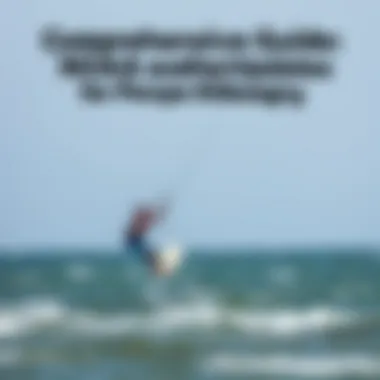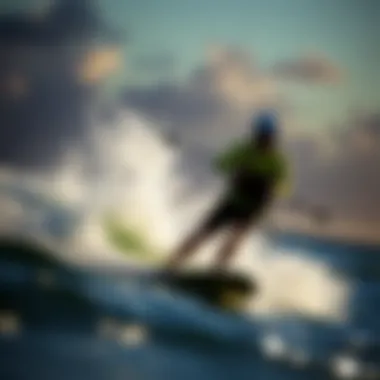Essential NOAA Weather Updates for Pensacola Kiteboarding


Intro
Kiteboarding in Pensacola is not just a pastime; it’s a dance between human skill and the capricious winds of the Gulf Coast. Safeguarding that experience and enhancing it begins with being well-informed—this is where NOAA, the National Oceanic and Atmospheric Administration, becomes indispensable.
For those who dare to cut through the waves and soar above them, understanding NOAA updates is tantamount to unlocking the secrets of the weather. Whether you’re a seasoned kiteboarder planning your next big ride or a newcomer eager to catch the wind beneath your wings, having access to real-time weather insights transforms the experience. It’s like having a weather-savvy friend always in your corner, ready to dish out the latest forecasts and trends.
In this guide, we’ll delve into how NOAA equips you with the information to make informed decisions while kiteboarding, ensuring your safety and enjoyment. We'll highlight critical elements like real-time weather data, historical climate trends specifically tailored to the Pensacola area, and other unique meteorological features that can make or break your outing. Then, we’ll also venture into gear selection and skill development—insights that can be useful as you hit the water, confidently riding the winds and waves of Pensacola.
With a solid understanding of NOAA's resources, you can elevate your kiteboarding journey from a mere hobby to a thrilling adventure.
Gear Selection
Choosing the right gear is pivotal when heading out for a kiteboarding session. Not only does it affect your performance, but it also plays a role in your overall safety. Let’s break this down into two key components: kite types and board selection.
Types of Kites
When it comes to kites, there is no one-size-fits-all approach. Understanding the various kite types can enhance your experience dramatically:
- C-Kites: Best for freestyling and advanced maneuvers, these provide responsiveness that experts love.
- Bow Kites: Known for their versatility, they are ideal for those new to the sport or heavier riders seeking lift.
- Hybrid Kites: A blend between C-kites and Bow kites, they offer a good balance for intermediate kiteboarders looking for both power and control.
Choosing the right kite not only affects how you handle the wind but also how much fun you have out there on the water.
Choosing the Right Board
Alongside kites, your board selection also plays an integral role. Keep these factors in mind as you make your choice:
- Size: Smaller boards provide speed and agility, while larger boards offer stability and easier handling in light winds.
- Type: Freeride boards focus on general riding and tricks, whereas surfboards are tailored for those wishing to ride waves.
- Material: Lightweight materials provide better performance but might sacrifice some durability on rough days. Choose wisely.
The board you ride can make a world of difference, so understanding how different boards interact with water and wind conditions is vital for maximizing your kiteboarding sessions.
As we dive deeper into this guide, you'll discover more about crucial skills and techniques to further your kiteboarding endeavors in this striking locale.
Prolusion to NOAA Weather Services
A solid grasp of NOAA weather services is pivotal for anyone living in or engaging with the coastal environment of Pensacola, particularly for kiteboarders who rely on accurate weather updates. The National Oceanic and Atmospheric Administration (NOAA) serves as the backbone for weather forecasting, providing critical data and resources essential for safety and enjoyment.
As the saying goes, "forewarned is forearmed." Having timely access to reliable weather information helps kiteboarders not only plan their outings but also avoid tricky weather conditions that could pose risks. In this regard, understanding NOAA's offerings can't be overstated.
Often, it isn’t just about hitting the water when the breeze feels right; there’s a multitude of factors at play. From wind patterns to potential weather fronts, emerging situations can change in the blink of an eye. Knowledge of NOAA’s services equips kiteboarders with the tools to monitor their environment actively. This section will delve into important facets of NOAA’s role in weather forecasting and its significant impact on local communities.
Understanding NOAA's Role in Weather Forecasting
NOAA is more than just a government entity—it’s a vital resource for weather forecasting and environmental monitoring. The agency employs sophisticated technology to analyze meteorological data, generating forecasts that cater to local needs. For instance, radar systems and satellite imagery are pivotal in tracking hazardous weather conditions that could threaten coastal activities.
NOAA's National Weather Service (NWS) provides real-time alerts and updates, allowing users to develop a keen understanding of unfolding weather conditions. The information is derived from an extensive network of observation stations and weather models, making these forecasts not only timely but also pertinent. By utilizing NOAA's tools, kiteboarders can obtain insights into:
- Current wind conditions: Crucial for selecting the right time to hit the water.
- Forecasted storms: Knowing when a storm might arrive can mean the difference between a fun day on the water and a dangerous situation.
- Special weather advisories: These keep enthusiasts informed about unusual weather events that may affect kiteboarding activities.
Importance for Local Communities
In neighborhoods like Pensacola, where weather can be unpredictable, understanding NOAA's mission is a community asset. Local communities thrive when residents have access to timely and accurate weather information, leading to informed decision-making.
The importance of NOAA extends beyond just kiteboarders. Every resident can benefit from a well-informed community prepared for various meteorological scenarios. Consider the fishermen who depend on weather updates to optimize their catch or families planning weekend outings. Ensuring that everyone is on the same page when it comes to weather safety fosters a sense of unity and resilience.
"Weather affects us all. Accurate information is not just useful; it’s a necessity."
Engagement with NOAA's services promotes a proactive stance on weather preparedness. Schools and local organizations often collaborate with NOAA to conduct workshops that equip citizens with the know-how necessary to interpret forecasts and respond effectively to weather-related threats. Thus, through NOAA, local communities in Pensacola can amplify their understanding and appreciation of climate patterns, ultimately creating a safer environment for all.
In summary, NOAA’s weather services are indispensable for residents in Pensacola, especially those engaged in kiteboarding. Not only do they elevate personal safety, but they also promote community awareness and preparedness. This lays the groundwork for further exploration of weather resources, providing opportunities for locals to engage even deeper with their environment.
Weather Resources Specific to Pensacola
For kiteboarding enthusiasts and the broader community in Pensacola, having timely and accurate weather information is nothing short of vital. Weather resources specific to Pensacola can help in planning sessions on the water, ensuring safety, and understanding the local climate's peculiarities that can have a direct impact on kiteboarding experiences. It transcends mere weather updates; it’s about making informed decisions that can significantly enhance the enjoyment and safety of your time spent on the waves.


Accessing Local Forecasts
Understanding local weather forecasts is key to successful kiteboarding. The National Oceanic and Atmospheric Administration (NOAA) provides a plethora of tools that are beneficial for kiteboarders. One of the primary means of accessing local forecasts is through their website or local broadcasting stations that provide tailored reports for the Pensacola area.
Local forecasts typically include relevant metrics like wind speed and direction, temperature, and precipitation chances. For example, knowing the wind speed can make or break a kiteboarding outing. Winds around 10 to 20 knots are often optimal for kiteboarders. If the forecast indicates sustained winds of 25 knots or more, it might be prudent to reconsider your plans if you’re not an experienced rider.
The NOAA Weather Radio is another resource, prominently featuring local weather updates. This radio service provides continuous broadcasts of weather information, including emergency alerts. These alerts can be life-saving when conditions turn unfavorable unexpectedly. By tuning into this station, you can stay well-informed and ahead of any danger that may arise while kiteboarding.
In short, to access local forecasts effectively means relying on credible sources that speak to conditions that are pertinent for kiteboarding. Using NOAA forecasts can provide peace of mind and a better grasp of what to expect in terms of weather.
Mobile Apps and NOAA Alerts
With the advent of technology, having weather information at your fingertips is now more accessible than ever. Numerous mobile applications can push real-time NOAA alerts directly to users’ smartphones. Apps like Weather Underground and Windy, among others, facilitate quick access to the vital data kiteboarders need.
NOAA’s own mobile app provides a unique feature of alert customization, allowing users to select specific types of alerts that they wish to receive. For instance, you can set alerts for high wind warnings or updates on thunderstorms which can disrupt kitesurfing plans. This customized approach enables kiteboarders to tailor their experiences specifically to their needs.
Moreover, the integration of maps and radar features into these apps can present a more comprehensive overview of prevailing weather patterns. Kiteboarders can visualize wind direction, spot potential storms, and adjust their plans accordingly, which is essential in a place like Pensacola where coastal conditions can shift rapidly.
Staying connected through mobile apps can ensure you avoid adverse weather conditions while kiteboarding, allowing for safer and more enjoyable sessions.
Climate Considerations for Pensacola
Understanding the climate of Pensacola is crucial, particularly for kiteboarding enthusiasts who wish to optimize their experience while prioritizing safety. The relationship between weather patterns and ocean conditions further underscores the need for kiteboarders to be well-informed about seasonal changes, typical weather events, and the overall climate of the region. With a firm grasp of these elements, kiteboarders can make informed decisions, enhancing both their enjoyment and safety.
Understanding the Local Climate
Pensacola's climate is classified as subtropical, characterized by hot summers and mild winters. The region enjoys ample sunshine most of the year, which is a boon for outdoor activities. However, there's much more to consider here.
- Humidity: The humidity levels can be oppressive, particularly during the summer months, making it important for kiteboarders to stay hydrated and recognize the signs of heat exhaustion.
- Rainfall: While scattered showers can happen, especially in the summer, they tend to clear quickly. This can lead to unpredictable shifts in conditions, making it vital for kiteboarders to check the NOAA updates regularly.
- Winds: Winds typically blow from the southeast, providing favorable conditions for kiteboarding most of the year. Still, it’s essential to monitor wind speed and direction as they can change with little warning, especially during frontal systems.
In summary, being aware of these local climatic traits helps kiteboarders plan their outings more effectively, ensuring they are prepared for any eventualities.
Seasonal Changes and Their Impacts
Each season in Pensacola brings unique weather patterns that can affect kiteboarding conditions significantly.
- Spring: This season is characterized by increasing temperatures and typically strong winds. Kiteboarders can take advantage of these conditions, but sudden thunderstorms can occur. Checking NOAA forecasts is critical during this time.
- Summer: The peak of summer can bring intense heat and high humidity, coupled with the occasional tropical storm. Many enthusiasts enjoy the consistent winds, but it's essential to prioritize safety amid the higher likelihood of severe weather events.
- Fall: As temperatures begin to cool, wind patterns can shift, creating periods of excellent kiteboarding conditions. The hurricane season peaks during this time, so extra caution is warranted.
- Winter: Though milder, winters can still present kiteboarding opportunities with cooler temperatures but less consistent wind. The low humidity makes for comfortable conditions, although strong fronts can bring unpredictable weather changes.
Understanding these seasonal variations helps kiteboarders not only prepare but also align their expectations with the conditions they are likely to encounter. Regular updates from NOAA can provide vital, up-to-date information about potential changes, thereby enhancing both safety and enjoyment on the water.
"By closely monitoring weather updates and understanding our local climate, we are better equipped to thrive in the dynamic environments we love to explore."
In summary, staying informed about the climate of Pensacola is key to maximizing kiteboarding experiences while ensuring safety in a location subject to varying weather conditions. By tapping into NOAA resources and having a clear understanding of seasonal changes, kiteboarders can navigate these waters with confidence.
Kiteboarding in Pensacola: Weather's Role
Kiteboarding is not just a hobby for many in Pensacola; it’s a way of life. Understanding the interplay between kiteboarding and weather conditions is vital to fully enjoy this thrilling activity. Pensacola's unique coastal environment requires kiteboarders, instructors, and enthusiasts to stay informed on real-time weather updates. Therefore, all of the available resources from NOAA play an indispensable role in ensuring the safety and enjoyment of every trip out on the water.
Kiteboarding can be incredibly rewarding, being able to ride the wind and feeling the rush of the waves. However, weather nuances can turn an exhilarating day into a sketchy adventure if you’re caught off-guard. Thus, understanding local weather patterns, tides, winds, and conditions is paramount to kiteboarding safely in Pensacola.
Optimal Conditions for Kiteboarding
When it comes to kiteboarding, the right conditions make all the difference. Firstly, let's break down what optimal conditions look like in the Pensacola area:
- Wind Speed: Ideally, kiteboarders prefer winds ranging from 12 to 25 miles per hour. Too little wind can leave riders stranded, while winds over 25 mph may be risky for all but the most skilled. Therefore, keeping an eye on the NOAA updates for wind forecasts is essential.
- Wind Direction: In Pensacola, the wind direction can vary. For kitesurfing, an onshore wind is often most preferred as it allows for redirects and better control. Cross-shore winds can be manageable, but they demand more experience from the rider.
- Water Conditions: Flat water is often more forgiving and better for beginners. However, experienced riders might enjoy some chop or waves. Knowing when the waves will be up or when it will be glassy calm can really set the stage for a great adventure.
By monitoring local weather reports and NOAA conditions, kiteboarders can strike while the iron is hot, ensuring they catch those prime conditions and make the most of their time on the water.
Safety Considerations Related to Weather
Safety can’t be overstated when kiteboarding. Mother Nature can surprise even seasoned experts, so it’s always best to be prepared.
- Severe Weather Alerts: NOAA provides crucial information on severe weather conditions, including thunderstorms and heavy rains. Kiteboarders should always check alerts and heed them. A sudden storm can wind up posing serious risks on the water, and safety should always come first.
- Tides and Currents: The Gulf of Mexico along Pensacola can have strong tidal shifts. Uneven tides can make it challenging to navigate, especially for those who may not be familiar with the area. Understanding tide schedules can prevent kiteboarders from getting swept out to sea.
- Personal Equipment Checks: Regularly inspect your gear for any wear and tear. Harnesses and kites need to be in tip-top shape, and weather can exacerbate the risks if equipment fails. It's worth noting that making sure your equipment works as it should starts with knowing the weather you might face.
Moreover, protecting oneself with a life jacket or impact vest is a good step. If something goes wrong, it could mean the difference between a safe return and a risky situation.


"Weather isn't just a backdrop in kiteboarding; it's a key player in the adventure. Stay informed, stay safe."
Utilizing NOAA Tools for Kiteboarding
Kiteboarding in Pensacola is not just a freestyle adventure; it requires a solid understanding of the weather, the winds, and the waves. Utilizing NOAA tools enhances not only the thrill but also the safety of kiteboarding. By leveraging real-time data and well-informed forecasts, kiteboarders can seize the best conditions on days that beckon exhilarating rides. This is where NOAA's vast range of resources comes into play.
Interpreting Weather Maps and Charts
Weather maps and charts might seem like a jigsaw puzzle, but for kiteboarders, they are invaluable tools. These maps offer a visual representation of the current weather patterns, showing pressure systems, wind directions, and even precipitation forecasts.
- Understanding Symbols: Each symbol on the map represents different weather phenomena. For instance, arrows indicate wind speed and direction, while colors on the chart can denote temperature ranges. A warm front might be represented by a red line with semi-circles, while cold fronts use blue lines marked with triangles.
- Analyzing Trends: It’s essential to look for trends rather than just the snapshot in time. For instance, if a high-pressure system is building up offshore, you might expect stable winds, but if low pressure is close, that could mean shifting winds. Keeping an eye on these changes helps in planning kiteboarding sessions effectively.
- Resourceful Sites: Websites like National Weather Service ( https://www.weather.gov) provide an array of maps, tailored specifically to marine forecasts that can help in making smarter decisions.
"Knowledge is power; understanding weather maps means power for the kiteboarder."
Using Weather Radars Effectively
Radar technology has progressed tremendously and can offer timely information crucial for kiteboarders. Radars can detect precipitation and the intensity of rain, which is essential for planning your day on the water.
- Real-time Updates: Weather radar reflects real-time changes in the atmosphere. For instance, if a rainstorm is brewing nearby, the last thing you want is to be caught unprepared out on the water. By observing radar updates, kiteboarders can make informed decisions to either hit the water or hold off.
- Cross-referencing: Combining radar data with forecasts can provide a clearer picture. For instance, if the forecast predicts storms, but radar shows clear skies, there may be some time to ride before the weather turns bad.
- Interactive Resources: Platforms like NOAA Radar Online ( https://radar.weather.gov) offer interactive tools that can pinpoint radar locations, making it easy to see how weather patterns develop.
Utilizing these NOAA tools goes beyond just having fun on the water; it's about fostering a safer and more knowledgeable kiteboarding community in Pensacola. By making sense of weather maps and tapping into radar data effectively, every kiteboarder can elevate their game while ensuring safety is always at the forefront.
Understanding Marine Weather Forecasts
Understanding marine weather forecasts is crucial for kiteboarders in Pensacola, a city where wind and water conditions can change quicker than a cat can lick its ear. These forecasts are specially designed to provide vital details that directly influence safety and enjoyment on the water. Kiteboarding enthusiasts, from beginners to seasoned pros, depend heavily on these updates to make informed choices before hitting the waves.
Marine weather forecasts deliver information about wind speed, direction, wave height, and potential weather disturbances. All these factors play a pivotal role in kiteboarding; a friendly breeze can quickly turn into a gnarled gust if not monitored closely. Understanding these elements allows kiteboarders to not only anticipate optimal conditions but also prepare for adverse weather that could lead to dangerous situations.
Incorporating forecasts into pre-ride checks is a practice every kiteboarder should adopt. For instance, if a forecast warns of increasing wind speeds coupled with switching directions, it may be prudent to pack up rather than press your luck. With NOAA providing high-quality, timely data, kiteboarders can make wise decisions that enhance their riding experience while ensuring safety.
"The best surfer out there is the one having the most fun." - Duke Kahanamoku. This quote embodies how vital it is to enjoy the ride, and enjoying it safely is a critical component.
Significance of Marine Forecasts for Kiteboarders
For those who love kiteboarding, marine forecasts are the bread and butter of a good day on the water. They help in dissecting the marine environment into digestible bits of info, enabling enthusiasts to assess risk and plan accordingly. Here’s why these forecasts are so significant:
- Wind Predictions: Kiteboarding heavily hinges on wind for propulsion. Forecasts provide insights into expected wind strengths and directions, which can help in choosing the right gear.
- Water Conditions: Knowing wave heights and swell activity can transform the kiteboarding experience from mundane to magnificent, or turn it into a nightmare if conditions are less than ideal.
- Weather Alerts: Any shift in weather, such as thunderstorms or rapidly changing patterns, is crucial information that can save lives and ensure a kiteboarder’s safety.
Ultimately, staying updated with marine forecasts gives kiteboarders a tactical edge, allowing them to maximize their fun while minimizing risks.
Specifics of Coastal Weather Patterns
The coastal weather patterns around Pensacola can be likened to a coin that boasts two distinct sides. On one side, you have the ocean’s gentle breezes that lull you into a state of euphoria, and on the flip side, you may find sudden storms lurking just beyond the horizon. Understanding these patterns is integral for kiteboarders, as they influence usability and risks overall.
Coastal weather can be characterized by low-pressure systems and fronts moving in from the Gulf of Mexico. This can lead to:
- Sea Breezes: Localized winds that typically increase during the day, often providing ideal kiteboarding conditions.
- Thunderstorms: Frontal systems can generate severe weather that brings thunderstorms, requiring caution and quick retreats when staying safe is a must.
- Temperature Inversions: Changes in temperature can cause shifts in wind patterns, adding to the complexity for those taking to the waters. Knowing when these inversions may occur can be a game changer.
Catching the right information about coastal weather patterns helps kiteboarders plan their outings better, ensuring they enjoy every moment on the water while steering clear of unwelcome surprises.
Historical Weather Patterns in Pensacola
Understanding the historical weather patterns in Pensacola is akin to holding a weathered map before embarking on an adventurous journey. It serves not just as a chronicle of nature’s whims, but also as a vital tool for kiteboarders who depend on favorable conditions for their activities. The weather doesn't just blink in and out; it carries stories and lessons from the past that can shape present decisions.
Historically, Pensacola’s climate showcases a diverse tapestry of weather events, including hot summers, mild winters, and occasional storms. This section delves into the significance of these patterns, offering important insights that can enhance both safety and enjoyment for those drawn to the winds and waters.
Analyzing Past Climate Trends
When we look back at past climate trends in Pensacola, several aspects pop out like stars in a clear night sky. The temperature averages, for instance, paint a picture of what kiteboarders might expect during various seasons. Historical data indicates that summers frequently reach the high 90s °F, making water sports an ideal way to beat the heat. On the other hand, the milder winters, with temperatures lingering in the 50s °F, can offer unique kiteboarding experiences for those unafraid of cooler breezes.
Moreover, the rainfall patterns play a crucial role. An analysis of precipitation data suggests that late summer, particularly around August, tends to bring heavy rains and tropical systems that can impact the sea state and wind conditions. Understanding these cycles helps kiteboarders plan their sessions better, dodging periods of inclement weather and seizing the best moments when winds kick up.
"Weather is a language that tells us all the time what is happening and what is going to happen next."
Impact of Historical Patterns on Kiteboarding


The impact of historical weather patterns on kiteboarding extends beyond mere forecasts. By linking past trends to current kiteboarding practices, enthusiasts can glean wisdom lost in time. For example, the historical data surrounding hurricane activity typically peaks in late summer and early fall, a crucial consideration for kiteboarders planning outings.
Each storm or significant weather event does not just mark a calendar; it reshapes landscapes and water conditions. Apart from understanding when to avoid the sea, it’s beneficial to recognize how kiteboarders have adjusted their techniques and destinations based on historic weather patterns. Wind strength and direction, crucial for successful kiteboarding, often follow patterns established over the years. Familiarity with these nuances allows participants to make informed decisions, avoiding dangers while maximizing fun.
By weaving together the threads of history and personal kiteboarding experiences, local riders can build a collective knowledge base that benefits everyone from novices to seasoned veterans. As you navigate the waters of Pensacola, carry the lessons of the past along with you – they’ll steer you clear of storms and into the sweet spots of the surf.
Impact of Severe Weather Events
Understanding how severe weather events can influence kiteboarding in Pensacola is a fundamental aspect of this guide. From hurricanes to intense thunderstorms, these weather phenomena can have both immediate and long-term effects on safety and conditions for kiteboarders. The necessity for awareness in this regard is not just a theoretical concern; it’s vital for the well-being of individuals who take to the water.
Understanding Hurricane Season
Hurricane season runs from June 1 to November 30, with peaks typically in August and September. This timeframe brings the risk of tropical storms and hurricanes, which can not only change the water conditions drastically but also pose serious safety issues. Kiteboarders need to be aware of the potential for rapidly changing weather. Even seemingly calm days can escalate into severe wind conditions quickly.
During hurricane season, checking NOAA forecasts and local warnings becomes essential. These reports provide updates on storm paths, wind speeds, and potential surges that may affect the coastline. For example, in 2020, Hurricane Sally made landfall near Pensacola, causing extensive beach erosion and altering the usual conditions where kiteboarding occurs. Knowledge of these events can mean the difference between a safe session or an unscheduled swim back to shore.
Preparing for Severe Weather as a Kiteboarder
As a kiteboarder in Pensacola, preparation is key when it comes to severe weather. Here’s how to stay ahead of the game:
- Stay Informed: Regularly check NOAA weather updates. Utilize mobile apps and local radio stations for real-time notifications.
- Know Your Limits: If the forecast warns of strong winds or heavy surf, it’s wise to avoid the water. Better safe than sorry.
- Emergency Gear: Always have safety and emergency supplies, such as a whistle, a floating device, and an emergency kit. These can be life-saving during unexpected situations.
- Community Knowledge: Engage with fellow kiteboarders and local instructors. Share information and experiences on how to interpret weather data effectively.
"Preparation is everything. Understanding severe weather not only enhances your kiteboarding experience but also ensures your safety."
Being proactive in your approach to weather events can help mitigate risks significantly. Keep in mind that while the thrill of kiteboarding is undeniable, the ocean’s mood can change in the blink of an eye. Embrace the resources available through NOAA and enhance your riding experience while ensuring a responsible approach to safety.
Community Engagement and Education
Engagement and education play a pivotal role in enhancing the experiences of kiteboarders in Pensacola. With the unpredictable nature of weather patterns, equipping the community with knowledge not only fosters safety but also cultivates a deeper appreciation for kiteboarding. It's not just about riding the waves; it's about understanding the environment one participates in. By focusing on community initiatives that promote learning, kiteboarders can make well-informed decisions that elevate their time on the water while simultaneously mitigating risks associated with sudden weather changes.
Workshops on Weather for Kiteboarders
Workshops specifically dedicated to weather education for kiteboarders are instrumental in bridging the gap between technical knowledge and practical application. These workshops can provide an overview of local weather patterns, covering critical aspects such as wind direction, intensity, and the impact of various meteorological phenomena.
The benefits of these workshops are manifold:
- Interactive Learning: Participants engage in hands-on activities that offer real-time analysis of weather data.
- Expert Guidance: Local meteorologists or experienced instructors can share insights tailored to the needs of kiteboarders.
- Safety Protocols: Workshops can address emergency preparedness, equipping participants with protocols to follow in severe weather conditions.
Through workshops, attendees gain tools to interpret weather updates, empowering them to choose optimal times for kiteboarding. For instance, recognizing the signs of an impending storm or deciphering NOAA alerts can be crucial. Imagine being out there, kite in hand, only to find out a storm is headed your way. Knowledge is not just power; it’s the difference between a thrilling experience and a hazardous one.
Building a Knowledgeable Kiteboarding Community
A knowledgeable kiteboarding community is more than just a group of enthusiasts; it’s a network that supports growth and safety. Creating forums—both online and in-person—can facilitate discussions where kiteboarders share their experiences and weather-related insights.
Here are some ideas on how such a community can flourish:
- Online Forums: Platforms like Reddit and Facebook allow kiteboarders to exchange real-time updates on weather conditions and tips. Links to discussions can be found at reddit.com/r/kiteboarding and facebook.com/Kiteboarding.
- Local Clubs: Establishing or joining local kiteboarding clubs encourages collaboration and knowledge-sharing. Club meetings can feature guest speakers from weather services, creating opportunities for everyone to learn together.
- Resource Sharing: Members can share apps, weather tools, and NOAA updates directly, fostering independent learning.
Building a community that emphasizes education enhances the collective intelligence of kiteboarders. When everyone understands how to navigate weather forecasts, not only do individual experiences improve, but the entire kiteboarding scene in Pensacola thrives. A knowledgeable kiteboarder can better advocate for safety practices and inspire newcomers to prioritize understanding weather before hitting the waves.
"Informed kiteboarders create a safer, stronger community—sailing into the sunset with knowledge in their sails."
Epilogue: The Future of Weather-Related Resources
The ever-evolving landscape of weather forecasting continues to play a crucial role in shaping various activities, particularly for kiteboarders in Pensacola. As technological advancements pave the way for more precise weather updates, understanding how to leverage these resources becomes paramount. Gaining insights from NOAA's tailored updates can enhance not just safety but also the overall experience on the water. The future of these resources lies in their ability to provide real-time information that aligns closely with the dynamic conditions characteristic of this region.
The Evolving Role of NOAA in Local Weather Spaces
NOAA has transitioned from merely providing forecasts to becoming an active, integrated part of the local community’s resilience to weather events. This evolution is important as it ensures that individuals can tap into localized data that reflects conditions in real-time. For instance, the use of predictive analytics allows NOAA to anticipate weather trends, offering kiteboarders timely alerts about potential changes in wind speed or storm developments that might close off their favorite spots.
Through partnerships with community organizations and local government, NOAA can disseminate targeted information that relates specifically to Pensacola's diverse weather patterns. This not only augments safety but also aids in planning kiteboarding activities around the best conditions available. Embracing the evolving technologies will allow NOAA to continue enhancing its role in safeguarding both recreational and professional kiteboarders.
Encouraging Responsible Kiteboarding Practices
Kiteboarding, while exhilarating, carries inherent risks, especially when weather conditions shift suddenly. As NOAA enhances its prediction capabilities, encouraging responsible practices becomes a shared responsibility between the organization and the kiteboarding community. By promoting awareness about the importance of checking weather updates before heading out, NOAA fosters a culture where knowledge becomes power.
- Stay Educated: Kiteboarders are encouraged to participate in workshops that NOAA offers, focusing on interpreting weather updates and understanding marine forecasts. This heightened awareness makes it easier to recognize adverse weather conditions.
- Follow Alerts: When NOAA issues alerts, it's imperative for kiteboarders and instructors to heed this information. Ignoring serious weather warnings can lead to unfortunate incidents.
- Community Communication: Engaging with local kiteboarding communities can further enhance safety practices. Sharing experiences and updates creates a network of informed kiteboarders.
As the resources and technologies evolve, the kiteboarding community must also adapt. The key takeaway is that by integrating NOAA weather updates into daily practices, kiteboarders not only ensure their safety but also contribute positively to the sport’s sustainability in Pensacola.
Understanding the weather is as crucial as mastering the winds and waves.















